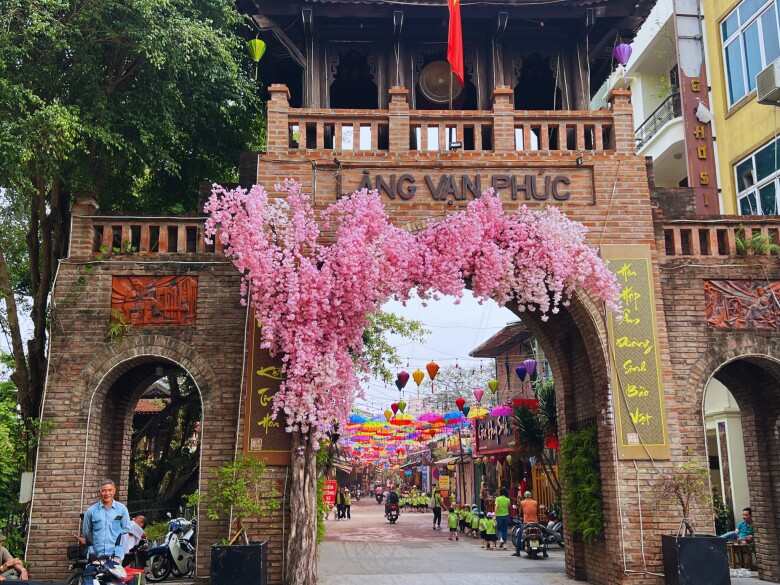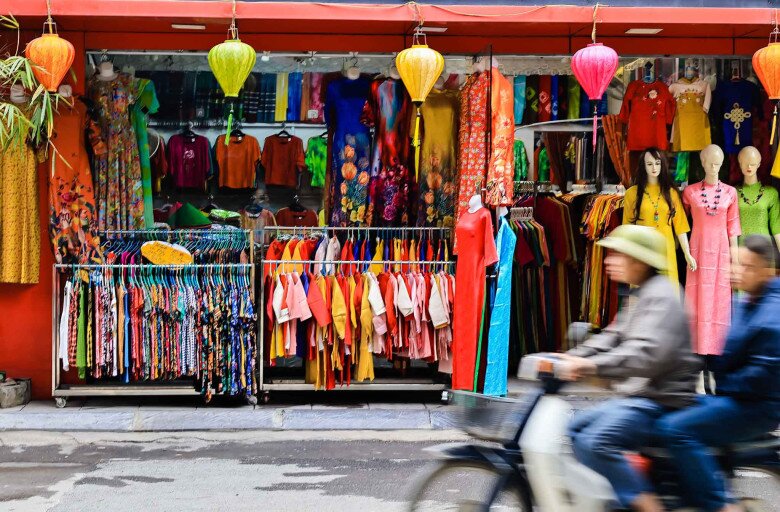Silk Market in the Traditional Craft Village of Van Phuc
Van Phuc Silk Market is located in the traditional craft village of Van Phuc Silk, in Ha Dong district. Van Phuc Silk Village, also known as Ha Dong Silk Village, is situated in Van Phuc ward, Ha Dong district, on the banks of the Nhue River, about 10 km from the center of Hanoi. It is one of the over 1,000 traditional craft villages that are still preserved in Vietnam.

Van Phuc Silk Village has a long history of traditional weaving that dates back a thousand years. Despite the strong urbanization process, the village still retains the characteristics of the old countryside, such as the village gate, banyan tree, well, and communal house. Currently, nearly 800 households in the village continue to practice the traditional silk weaving profession, accounting for nearly 60% of the total number of households living here. Each year, the Van Phuc Silk Village in Ha Dong produces about 2.5 to 3 million square meters of fabric, accounting for 63% of the village’s total revenue.

According to archaeological documents and ancient artifacts, the silk weaving profession in Van Phuc appeared about 1000 years ago. Initially, the village was named Van Bao, but it was later changed to Van Phuc to avoid the taboo of the Nguyen Dynasty.

Legend has it that about 1,100 years ago, the wife of the governor of Giao Chi, Cao Bien, once ruled this region. Mrs. La Thi Nga, the governor’s wife, taught the villagers how to make a living and passed on the silk weaving profession, which helped the weaving profession here develop and become a famous brand. During the Nguyen Dynasty, Van Phuc silk was favored by the royalty.

Not only famous domestically, Van Phuc silk is also exported internationally. In 1931 and 1932, Van Phuc silk was introduced at major fairs in Marseille and Paris. The French considered it a finely woven and top-quality fabric in Indochina. In 1958, Van Phuc silk began to be exported to Eastern European countries, bringing significant economic benefits to the country.

The Silk Market is a place to introduce, promote, and sell Van Phuc silk products. Each booth has a different arrangement, but they all feature colorful and vibrant products, including ao dai (Vietnamese traditional dress), scarves, clothing, and silk decorations.

In the past, Van Phuc silk was mainly used to make ao canh (a type of traditional Vietnamese jacket) and shirts. Today, artisans have become more creative by combining silk with modern suits, dresses, and other fashionable outfits. While the primary material for Van Phuc silk remains silk, artisans have skillfully blended it with other types of fabric to create new, highly competitive product lines that meet market demands.

Van Phuc Silk Village has long been famous for its unique and exquisite silk products. The village specializes in producing various woven silk products, including traditional silk and high-end lines such as brocade and velvet, along with many other special types of silk. Among them, Van silk stands out with its two main lines: van que hong diep (pink-leaved cinnamon) and luong long song phuong (two dragons and phoenixes). The distinctive feature of Van silk is the raised and sunken floral patterns, creating an attractive effect when illuminated. The artistic patterns on the silk reflect the skillful hands and creative eyes of the Van Phuc silk artisans.


Van Phuc silk products are diverse not only in their forms but also in their decorative patterns. The silk fabric in Van Phuc is often adorned with animal, plant, object, and graphic motifs. The Song Hac (Double Crane), Tho Dinh (Longevity Peak), and Tu Quy (Four Treasures) patterns are exemplary of the creativity and craftsmanship of the Van Phuc artisans.


The Silk Market and the Van Phuc Silk Village in Ha Dong remain an intriguing destination, attracting tourists from near and far. Today, the village still preserves its traditional cultural beauty, contributing to promoting the traditional silk profession, creating jobs, and improving the income of the locals.































